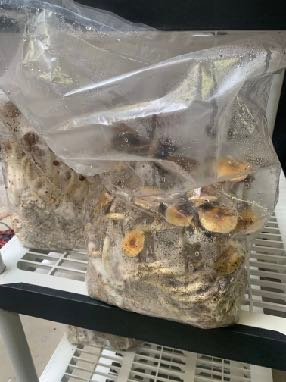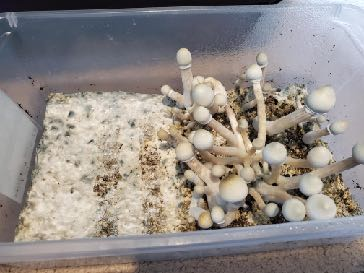What is Fresh Air Exchange (FAE)?
Fresh Air Exchange (FAE) is the process of introducing oxygen and removing carbon dioxide to induce the fruiting stage in mushroom cultivation. FAE is crucial for mushroom pinning and healthy growth, ensuring that your Psilocybe Cubensis or other mushroom varieties develop properly.
How Does FAE Work?
Once your mushroom grain spawn is fully colonized, the next step is to transfer it to a bulk substrate. This stage requires careful air circulation to promote mushroom formation while maintaining proper humidity levels.

Common FAE techniques include:
✅ Manually fanning the grow chamber with the lid of a monotub.
✅ Using an oscillating fan on a timer to improve air circulation.
✅ Adjusting the gussets on grow bags to regulate airflow.
Maintaining the right balance between humidity and airflow can be tricky, especially for beginners. However, understanding optimal fruiting conditions will help maximize yields.
How Much FAE Do Mushrooms Need?
Not all mushrooms require the same levels of fresh air exchange.
- Psilocybe Cubensis can tolerate lower FAE compared to other varieties.
- Panaeolus Cyanescens requires high humidity and constant air circulation, making it harder to grow without specialized humidification systems.
FAE should always be adjusted based on your grow setup, whether you’re using grow bags, monotubs, or a fruiting tent.

FAE and Contamination Risks
While introducing fresh air is essential for growth, it also increases the risk of contamination. If your growing environment is not sterile, contaminants like Trichoderma (green mold) can quickly spread.
How to Prevent Contamination
Use sealed grow bags instead of open-air monotubs to reduce exposure to airborne contaminants.
Keep your environment clean—avoid growing near carpets or areas with pets.
Sanitize your monotub before every use to eliminate contamination vectors.
Balance FAE with humidity—excessive air exchange can dry out the substrate, reducing fruiting potential.
Monotubs vs. Grow Bags: Which is Better for FAE?
| Feature | Monotub | Grow Bag |
|---|---|---|
| Fresh Air Exchange | Higher due to lid gaps and drilled holes | Adjustable via gussets and sealing clips |
| Contamination Risk | Higher (requires frequent cleaning) | Lower (sealed design protects against contaminants) |
| Humidity Control | Harder to maintain | Easier to regulate |
| Ease of Use | Requires manual fanning | Minimal maintenance |
Our Spore Vision Grow Kit includes a resealable clip, allowing growers to adjust FAE by folding the gussets on the substrate bag to control airflow with ease.
The Key to Fruiting Conditions: Humidity and Airflow
Humidity and air circulation are the two most important factors for achieving a full canopy of mushrooms.
Ideal Fruiting Conditions for Psilocybe Cubensis
- Temperature: Mid-70s°F (24°C–26°C) for best colonization rates.
- Humidity: 80%–95% to support pin formation and fruiting.
- Air Exchange: Steady fresh air flow without excessive drying.
Warning: Once temperatures exceed 80°F, contamination risks increase. Keeping temperatures in the mid-70s reduces the chance of bacterial or mold infections.
Understanding Field Capacity for Proper Hydration
The right water content in your substrate is critical for healthy mycelium growth.
How to Test Field Capacity
- Grab a handful of substrate.
- Squeeze gently—water should slowly drip but not pour out.
- If water pools at the bottom of your container, add vermiculite to absorb the excess moisture.
Proper hydration ensures water droplets settle on the surface, encouraging mushroom pin formation and preventing premature drying.
Solutions for Maintaining High Humidity Without Mess
For Psilocybe Cubensis, you can grow with or without a casing layer.
What is a Casing Layer?
A casing layer is a non-nutritious material added on top of the colonized substrate to maintain high surface humidity.
Common casing materials include:
✅ Peat moss
✅ Vermiculite
✅ Coco coir
Benefits of a Casing Layer
✔ Regulates moisture at the surface of the substrate.
✔ Enhances pin formation by trapping humidity.
✔ Reduces the need for frequent misting.
Once the substrate is fully colonized, the casing layer can be:
- Incubated for a few days until mycelium starts poking through.
- Introduced to fruiting conditions immediately for faster results.
Example: Below, the right side of the monotub has a casing layer applied, while the left side does not. The cased side maintains better moisture and encourages even fruiting.
Final Thoughts: Mastering FAE for Maximum Yields
✅ FAE is essential for triggering fruiting conditions and increasing mushroom yield.
✅ Monotubs allow for high FAE, but require manual fanning and increased cleaning.
✅ Grow bags with filter patches offer controlled airflow and reduce contamination risks.
✅ Humidity and air circulation must be balanced to prevent drying out or contamination.
✅ A casing layer improves moisture retention and reduces workload.
By dialing in your FAE and humidity levels, you can optimize your mushroom flushes and grow stronger, healthier fruiting bodies!

Left: no casing layer Right: casing layer applied

